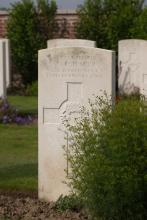Born in 1896, Victor was the only child of James and Mary nee Manson. A descendant of the first pakeha settler at Bluff in New Zealand's South Island, he lost both of his parents to tuberculosis before he was 10 years old and an infant brother to enteritis. Because of this Victor was raised by his Father's sister Mrs Goomes. After leaving school he was an apprentice engineer in Bluff and was a keen rower and was a member of a cox rowing crew. Victor answered the call for volunteers in April 1915, declaring his age to be 20 when it was actually 18. He stood 5 feet 4 inches tall and weighed 131 pounds, his complexion was dark hair dark and eyes brown. He entered Trentham Camp for training with the 6th reinforcements on 18th April 1915, during his initial training Victor was struck down with influenza just before his reinforcements departure overseas, he managed to recover quickly and 2 weeks later on the 14th of August he left NZ aboard the ship 'Willochra' as part of the 6th reinforcements of 2,363 men. Arriving in Egypt on 19th September, he was soon shipped off again to Mudros on the 1st of October 1915 and joined his new unit there 14th South Otago Company of the Otago Infantry Battalion who were recuperating there at Sarpi Camp after a much needed break from Gallipoli.
In early November Victor and his unit returned to the Gallipoli peninsula as it neared winter, mercifully the campaign was ended and as the snow increased the New Zealanders were withdrawn around the 20th of December from Anzac Cove finally reaching Egypt a week later. Victors 6 weeks at Gallipoli was a learning curve for what was to come, continued training in Egypt and the creation of the NZ Division saw Victor and his Otago Battalion now renamed 1st Battalion Otago Regiment depart from Egypt for France on the 6th of April 1916. Landing in Marseille a week later, his unit was moved towards Armentieres where they were placed in billets. Victor first entered the frontline here on the 21st of May 1916, with spells in and out of the line during this time it was not until his unit received an attack by German Mortar fire called Minenwerfer that the trouble began. Victor was partially buried in one of these attacks on the 10th of July, he was taken out of the line and treated at number 2 NZ Field Ambulance for shell shock. This moment would define his service, he was given light duties at the NZ divisional bath unit to help him recover 2 weeks later he was sent back to his unit in the front lines. He was immediately reported missing, caught by the Military Police on the 12th of August he was sentenced to 18 months imprisonment with hard labour. He was moved to Number 1 Military Prison at Rouen in September to complete his sentence, Victor was released to his unit early in June 1917 after completing half of his sentence. He remained with the 1st Otago's until going missing once again on the 13th of August. Found by Military Police again on February the 2nd 1918, Victor was living with a French woman and her 2 children. He was taken into custody and was to face a field general court martial, during his trial Victor stated that since Armentieres in July 1916 his health was not good and his nerve had been destroyed. His Captain also gave a character reference in his defense saying he was a good soldier and he could find no fault with him. The court decided not to call for medical evidence instead finding him guilty of desertion. It was ordered that he was to be shot by firing squad, his last rites were given by Chaplain Reverend Hoani Parata and at 6.40am on the 24th February 1918 Victor was executed by firing squad. Reverend Parata later wrote to his family telling them that he had met his death bravely and never flinched. Upon his death all of his pay was forfeited and his family were not eligible for his medals earned while in His Majesty's service. He was 1 of 28 kiwi soldiers sentenced to death during WW1 of which 5 were executed, the NZ government under Helen Clark pardoned these 5 men in the year 2000 and duly passed on Victor's medals to his family in 2005. (Barry Gamble Jan 2021)
His service record gives his date of birth as 1 November 1894 but BDM Online have it as 1 November 1896. If the latter date is correct he would have been 18 years old when he volunteered in April 1915.


